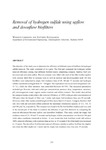Mostrar o rexistro simple do ítem
Removal od hydrogen sulfide using upflow and downflow biofilters
| dc.contributor.author | Limpaseni, Wongpun | es_ES |
| dc.contributor.author | Rattanamuk, Nattapol | es_ES |
| dc.date.accessioned | 2014-10-01T10:16:48Z | |
| dc.date.available | 2014-10-01T10:16:48Z | |
| dc.date.issued | 2007 | es_ES |
| dc.identifier.citation | Biotechniques for Air Pollution Control II, 2007: 273-282. ISBN: 978-84-9749-258-4 | es_ES |
| dc.identifier.isbn | 978-84-9749-258-4 | es_ES |
| dc.identifier.uri | http://hdl.handle.net/2183/12819 | |
| dc.description.abstract | [Abstract] The objective of this study was to determine the efficiency of different types of biofilters for hydrogen sulfide removal. The study consisted of two parts. The first part compared the hydrogen sulfide removal efficiency among four different biofilter media comprising compost, bamboo fluff soil, lava rock and activated carbon. The test columns were filled with each of the filter media together with coconut shell fiber to increase void as well as nutrient and microorganism seed. All four biofilters were subjected to empty bed residence time of 45, 60 and 75 seconds and hydrogen sulfide concentration ranged from 50 – 300 ppm. The experiment was run at room temperature (26- 33 °C), while the filter moisture was controlled between 60-70%. The measured parameters included gas flowrate, inlet and outlet gas concentration, pressure drop, temperature, moisture, pH, microorganism count, organic matter contents and sulfate contents. The results showed that the compost media could achieve the removal efficiency of 100% with gas inlet concentration of 300 ppm when the height of filter was 1 meter and empty bed residence time was 45 seconds. However, other filter media needed height of filter more than 1.25 meter. Compost, bamboo fluff soil, lava rock and activated carbon achieved the maximum elimination capacity of 122, 111, 72 and 108 g/m3-hr, respectively. The compost was found to be the best biofilter medium and was used in the second part of the study to examine the influence of gas flow direction by comparing the removal efficiencies between upflow and downflow biofilters. This study varied the empty bed residence times of 25, 50 and 75 seconds and hydrogen sulfide concentration was fixed at 300 ppm while other conditions remained as before. It was found that both biofilters could still achieve 100% removal efficiency with residence time as low as 25 seconds if the filter depth was increased to 1.5 meter. The downflow biofilter had removal efficiency similar to upflow biofilter, but slightly less when the filter depth was 1 meter and the empty bed residence time was only 25 seconds. | es_ES |
| dc.language.iso | eng | es_ES |
| dc.publisher | Universidade da Coruña | es_ES |
| dc.title | Removal od hydrogen sulfide using upflow and downflow biofilters | es_ES |
| dc.type | info:eu-repo/semantics/conferenceObject | es_ES |
| dc.rights.access | info:eu-repo/semantics/openAccess | es_ES |






